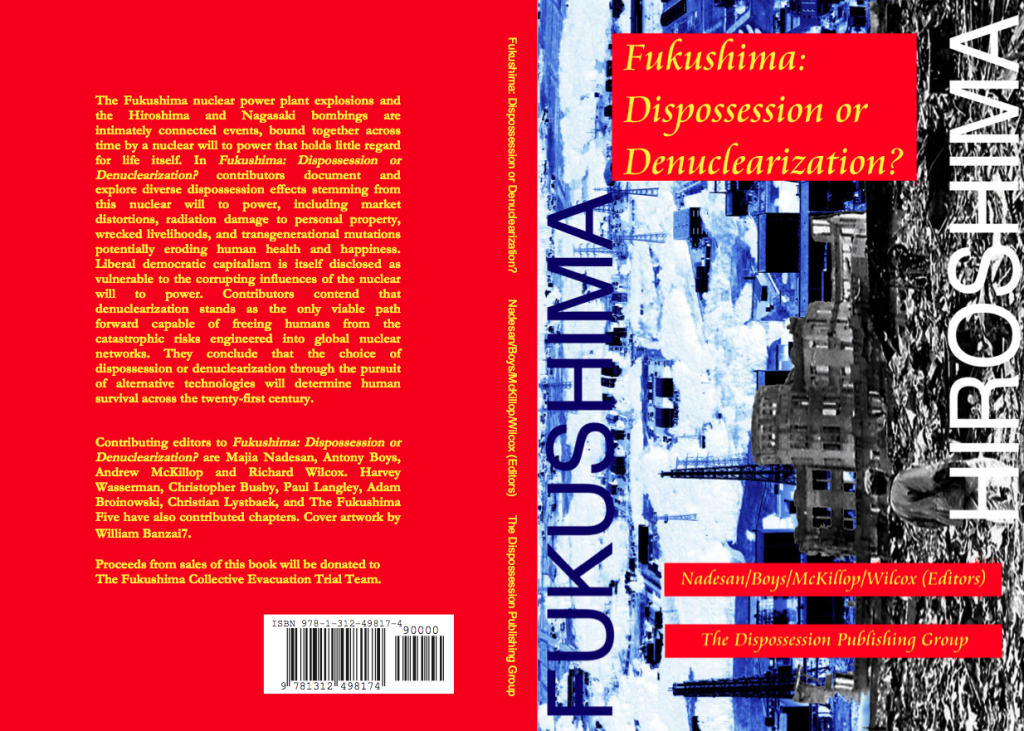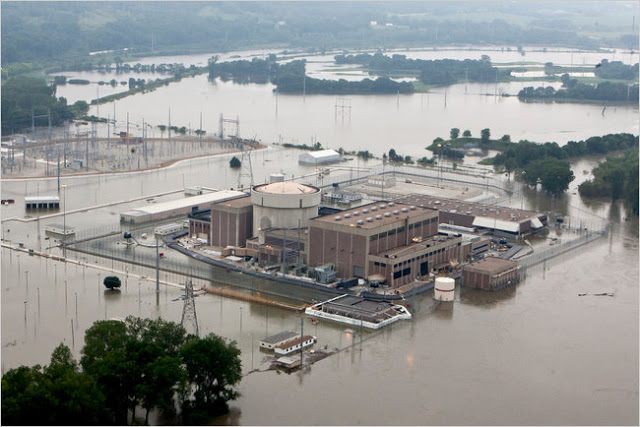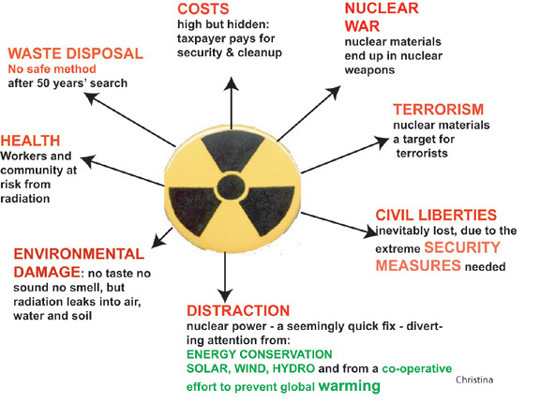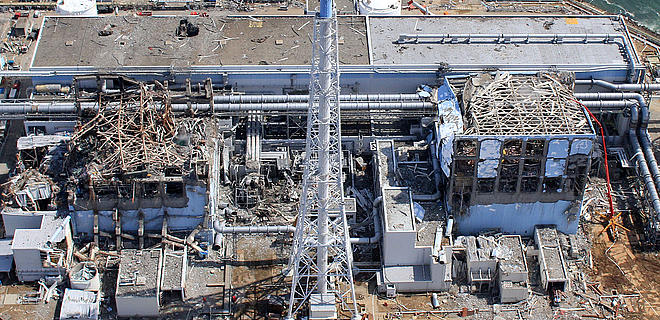“Fukushima: Dispossession or Denuclearization?” — The Final Chapter
“Fukushima: Dispossession or Denuclearization?” is a definitive and riveting book on the Fukushima nuclear catastrophe which has recently been published HERE. If there is one sober assessment of what this unparalleled event means to humanity, this scholarly yet practical review is it.
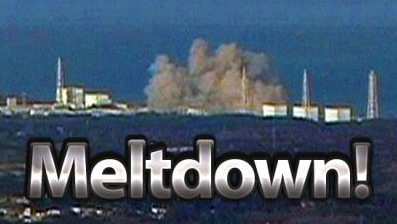 The last chapter of this extraordinary and eye-opening exposé provides only a glimpse into what are perhaps the most important messages that Fukushima has to deliver to humankind.
The last chapter of this extraordinary and eye-opening exposé provides only a glimpse into what are perhaps the most important messages that Fukushima has to deliver to humankind.
This exceptional treatment of the Fukushima disaster offers both uniquely penetrating insights and weighty conclusions. These inescapable conclusions must now be acknowledged, and responded to with great immediacy, by Japan and the world community of nations.
~~~~~~~~~~~~~~~~~~~~~~~~~~~~~~~~~~~~~~~~~~~~~~~~~~~~~~~
The Nuclear Energy Paradigm Collides with Earth Changes and Technospheric Breakdown
The Fukushima Five
The title of this chapter does not really represent its most important message. Undoubtedly, Earth changes are upon us in the form of increased seismic activity and volcanism. Global Climate Change is intensifying on every continent. And technospheric breakdown is accelerating by the year.
However, that the worldwide Nuclear Energy Industry (NEI), and the governments which regulate it, proceed down the same road despite these changing realities points to one thing in particular. As follows:
The voice of reason has fled humankind, especially within the scientific establishment which informs the Nuclear Energy Paradigm (NEP).
Likewise, common sense has become quite rare throughout the governments and corporations of the world where nuclear power generation has been promoted.
Because of this unfortunate state of affairs, critical decisions about the outworking of the Nuclear Energy Paradigm have been made, which have put whole populations around the world in great danger. In the same way, nations such as Japan have risked their future for the sake of clinging to an energy source which no longer makes any sense, nor ever did.
Why would the people of Japan put their four major islands in such jeopardy? “What jeopardy?” the Japanese politicians and officials at TEPCO ask.
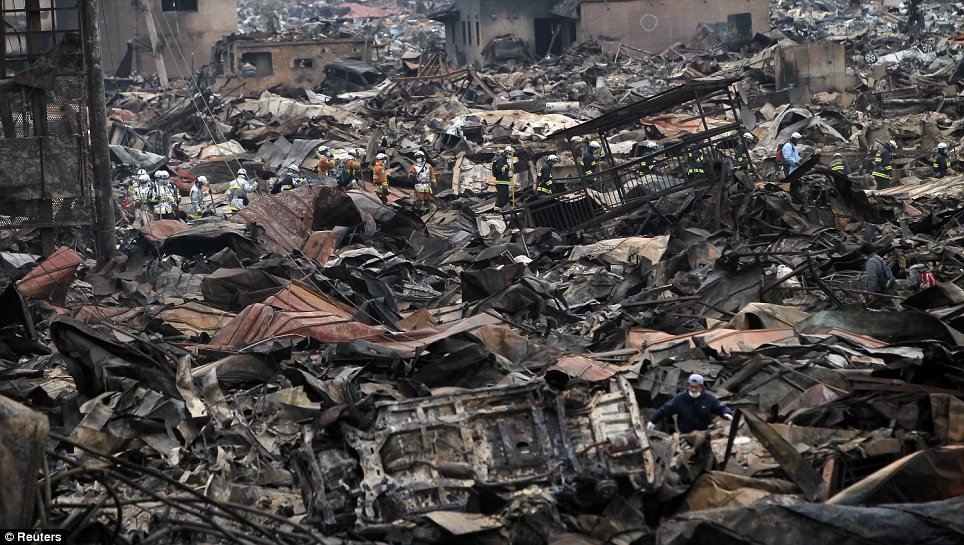 Aid workers make their way through debris and destruction after the March 11th tsunami struck Japan’s northeast coastline.
Aid workers make their way through debris and destruction after the March 11th tsunami struck Japan’s northeast coastline.
Just prior to the M9.0 earthquake and subsequent tsunami on March 11, 2011, Japan had 55 nuclear reactors in operation throughout the country, with an additional 12 approved and in various stages of development. Despite the fact that Japan is located in one of the most seismically active regions in the entire world, TEPCO and the Japanese government have relentlessly proceeded in the direction of nuclear power generation to meet the nation’s energy needs.
Our journey into the minds of those critical decision-makers begins here. Particularly in light of the fact that Japan was already the site of two nuclear disasters during World War II, one would think that the national and corporate leadership had been forewarned. And yet they proceeded to site virtually every nuclear power plant on the coastlines of the four main islands, exposed to all sorts of earthquakes and tsunamis.
First let’s establish that there is a huge difference between the risks and dangers associated with nuclear energy and those that simply don’t exist with hydrocarbon, hydroelectric, coal, solar and wind power generation models. When those power plants get hit by an earthquake, or overwhelmed by a tsunami, they simply shut down. There may be serious localized damage, but it’s usually very easy to contain and straightforward to fix.
Most importantly, such inevitable Earth change events will not precipitate a global catastrophe, as was the case with the Fukushima Nuclear Disaster. Whether by way of typhoon or tornado, earthquake or volcano, tsunami or flood Japan’s nuclear power plants, especially in view of their locations, will always remain extremely vulnerable. Hence, it can be stated with complete certainty that the responsible decision-makers committed a huge blunder by taking Japan in the direction of nuclear energy in the first place.
How has Common Sense Become Rare and the Voice of Reason Muted?
This entire chapter could easily end right here … end of discussion for any rational person who simply applies human reason to the predicament of Japan. How so? When a good answer cannot be provided to the following questions, what else is there to discuss about the viability of nuclear power generation on the most earthquake-prone island nation in the world?
1) What was the contingency plan at Fukushima, and for all the other nuke plants throughout Japan, should a tsunami overwhelm the plant buildings and completely cut off the electricity supply? When a long term disruption occurs, how will the reactors be cooled down?
2) How is a nuclear meltdown to be prevented in the wake of radioactive explosions and exceedingly high levels of radiation measured throughout the entire local area? How is the safety guaranteed of all the emergency personnel tasked with making the repairs necessary to prevent a meltdown or worse?
3) What was the TEPCO contingency plan in Fukushima should the power supply be cut off from the cooling pools where the spent fuel rods were being stored? What are the standard operating procedures in place throughout the rest of the nation’s nuke power plants?
If there is not a reasonable and actionable implementation plan for any of these predicaments, should they occur, then the plants simply shouldn’t be there. And, yet, there they sit — without any discussion of these and many other catastrophic contingencies — while the politicians in Tokyo talk about the coming Summer Olympics in 2020. It’s important to bear in mind that Tokyo is a mere 180 miles from Fukushima, and that some of the Olympics venues are even closer!
When the Faculty of Human Reason Fled Humankind
Not only does no one really know the extent of the environmental damage left in the wake of the Fukushima nuclear disaster, no one knows how it might further develop in the future. Nevertheless, the government persisted in their pursuit of the Olympics to be played out right in the backyard of perhaps the greatest nuclear catastrophe in history. The decision process in both cases cannot be driven by simple logic or rationality.
If ever there was an event which exposed a clandestine plot going on behind the scenes for several decades, Fukushima is it. Certainly those who have directed Japan’s destiny failed to take into consideration the obvious: That Japan occupies the most earthquake-ridden piece of real estate on the planet, and that Global Climate Change does not discriminate; it can show up on anyone’s doorstep uninvited and when least expected.
What the whole world has witnessed since that fateful day in 2011 is one earthquake after another, together with a number of severe storms buttressing the four main islands. In each instance, all of Japan’s neighbors — friends and foes alike — watch with baited breath for the many and various outcomes. Particularly in light of how precarious the situation at Fukushima continues to be, is the entire community of nations wondering if and when this intractable situation will be resolved? Clearly, we shouldn’t even be here, and wouldn’t be if those responsible had applied even a modicum of common sense during the incipient stages of development of Japan’s nuclear energy policy.
[youtube_sc url= http://www.youtube.com/watch?v=w3AdFjklR50&w=560&h=315]Graphic #2 — Japan 3/11/11 Earthquake: Helicopter Aerial View Video Of Giant Tsunami
Fukushima Feels the Brunt of the Perfect Storm
Fukushima is a perfect example of exactly what can go wrong, particularly when the Perfect Storm blows throughout the area. Just as Superstorm Sandy revealed just how old and antiquated much of the infrastructure is throughout Lower Manhattan, the March 11th earthquake and tsunami of 2011 allowed the many manmade problems and inherent weaknesses of the Fukushima Daiichi Power Station to surface over the course of the following weeks. Each day of the unfolding nuclear disaster seemed to bring a new development, none of them being positive. Some of these were expected; some came out of left field.
At the end of the day it was obvious that no power plant could withstand an M9.0 earthquake and 45-foot high tsunami (See Graphic [2]). However, even much lesser events could take greater tolls on such a vulnerable location as Fukushima … or Tokai (Tokai Village)… or Onagawa, the sites of other nuclear power plants. The moral of this story, and it is worth repeating until Japan — the whole nation — gets the message, is that they had NO business building these nuclear power plants along one of the most seismically active coastlines on the planet.
An article titled “Magnitude 6.8 earthquake off Japan coast triggers tsunami” (Associated Press) appeared in the media as this chapter was being written. Truly another telling sign that this whole predicament can be quickly duplicated anywhere along the Japanese coastline where nuclear power plants are located.
In addition to the constant threat of earthquakes and tsunamis, there is also the growing number of typhoons (Kageyama, Y.) making landfall on the Japanese coast. The increasing intensity of these storms is putting them in the same category as Superstorm Sandy. Therefore, they will undoubtedly serve to reveal more problems with the nuclear plants that dot the Japanese coastline should they receive direct hits in the future.
Global Climate Change Reveals Fatal Flaws of the Nuclear Energy Paradigm
While Fukushima is the poster child for everything that can go wrong — very wrong — with nuclear power generation, there have been several instances since March of 2011 which have highlighted the inherent weaknesses found in the global Nuclear Energy Paradigm.
Photos often tell the story much better than all the words in the world. The media carried startling photographs of Nebraska’s Fort Calhoun Nuclear Power Station during the floods of June, 2011. (See Graphics [3 and 4]) The plant was completely surrounded by floodwaters and under threat of losing its power supply. Even though it had been in cold shutdown since April, it was still vulnerable to problems not too dissimilar to the Fukushima Daiichi plant.
Graphic #3
As most of us know, the mainstream media rarely reflect the true gravity of either natural or manmade disasters. As an example, for days immediately following the M9.0 earthquake the media repeatedly reported a death toll of between 100 and 200 people after the tsunami struck the northeast coastline of Honshu Island on March 11, 2011. Certainly the authorities knew very quickly the devastation that the 45-foot high tsunami had inflicted. That whole towns and coastal villages were swept away became common knowledge after the first flybys. So was the fact that tens of thousands of Japanese citizens had been killed by this tragic event. Some of the most authoritative accounts have reported that upwards of 30,000 people passed away from the tsunami and aftereffects which lingered for months due to an exceptionally unresponsive government in Tokyo.
What’s the point? The governments (and the press) are both conditioned to grossly understate the seriousness of any matter which impacts so many citizens in any given area. Therefore, when the big media outlets do trumpet a genuine concern about the integrity of the nuclear power generation model, as they did in the wake of the Nebraska flooding, it can be safely assumed that some critical issues have not been thought out. Hence, we saw headlines like the following:
Flooding Brings Worry About Nebraska Nuclear Plants (Sulzberger and Wald)
Fort Calhoun Nuclear Plant: Flood Seeps Into Turbine Building At Nebraska Nuke Station (Funk and Lampe)
Flooded Nebraska nuclear plant floods, raises broader disaster fears (Hargreaves, S.)
The US Is Having A Catastrophic Nuclear Emergency In Nebraska And The Obama Administration Is Covering It Up (Blodget, H.)
Fort Calhoun Nuke Plant Flood Wall Collapse the Result of Accidental Puncture (The Doc)
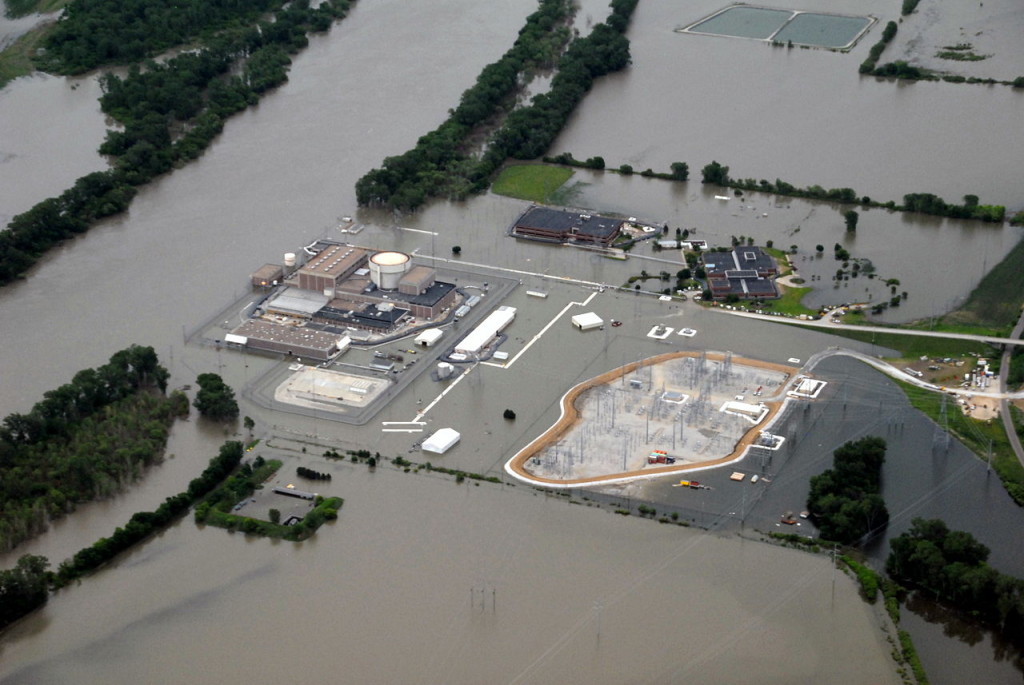
Fort Calhoun Nuclear Power Station
Graphic #4
There is one central and critical point which the preceding photographs graphically portray. Because of the ongoing intensification of Global Climate Change, this scenario can repeat itself virtually anywhere around the globe. Wherever there is a nuclear power plant, it can be overwhelmed by floodwaters if the rains and subsequent flooding are severe enough. When the plants are located on the coastline, as many are, to provide easy, inexpensive access to ample water supply, the threats greatly increase due to hurricanes and typhoons.
The real question remains, therefore, as to what type of contingency plans the various nations of the world have in place to address the worst case scenarios. The Perfect Storm that occurred at Fukushima can easily be duplicated in the form of a catastrophic weather event that temporally paralyzes a nuclear power plant, especially one that is in the way of raging floodwaters or a category 5 hurricane or typhoon.
It’s almost as though Mother Nature endangered two, not just one nuclear power plant, in 2011 as a way of showing the whole world that every plant is just a superstorm, earthquake, flood, or tsunami away from a full-blown nuclear disaster. In view of the government and corporate response during the Fort Calhoun flood, it’s clear that circumstances can, and do, arise which present extremely challenging predicaments. Sometimes they can be waited out; sometimes they can’t, as we have all seen with Fukushima.
Nuclear Energy Paradigm Fatally Flawed from the Start
The real problem here is that the very premises and assumptions underlying the NEP are fundamentally defective. It’s especially important to point out that the very scientific and technological foundation of this paradigm is woefully lacking. Particularly in light of the calamitous consequences that will occur when things go wrong, it is fair to say that the profound operating deficiencies and material defects of the NEP should have been significant enough to have prevented the nuclear power industry from building so many plants so quickly… everywhere on Planet Earth.
When a hydroelectric plant is incapacitated due to a storm, flood or earthquake, it only means the temporary loss of electricity generation. It is the same for a coal-fired power plant or biomass incinerator. When nuclear reactors are shut down on an emergency basis, and infrastructure is seriously threatened or damaged, what reasonably can be done? Particularly when the building and surrounding areas are permeated with escaping radioactive isotopes, even a meaningful first response can be drastically thwarted.
Of course, depending on the damage sustained by both building(s) and reactor(s), scenarios can easily develop which defy any kind of solution in both the short and long term. There are also instances, such as Fukushima, which will haunt a nation for generations to come, and in ways that are yet to be known or experienced because of the evolving complications.
At the end of the day, it will be completely understood that the state of the art (and science) which undergirds the nuclear energy industry is terribly underdeveloped. The design and engineering, architecture and materials are woefully substandard, especially when these bump up against Earth changes in the form of earthquakes or extreme weather events. Knowing that so many obvious deficiencies existed — “all over the place” — has guaranteed a future blighted by nuclear accidents both seen and unseen. Incidentally, it is the unseen and therefore unreported nuclear mishaps which can be the most dangerous to human life and property.
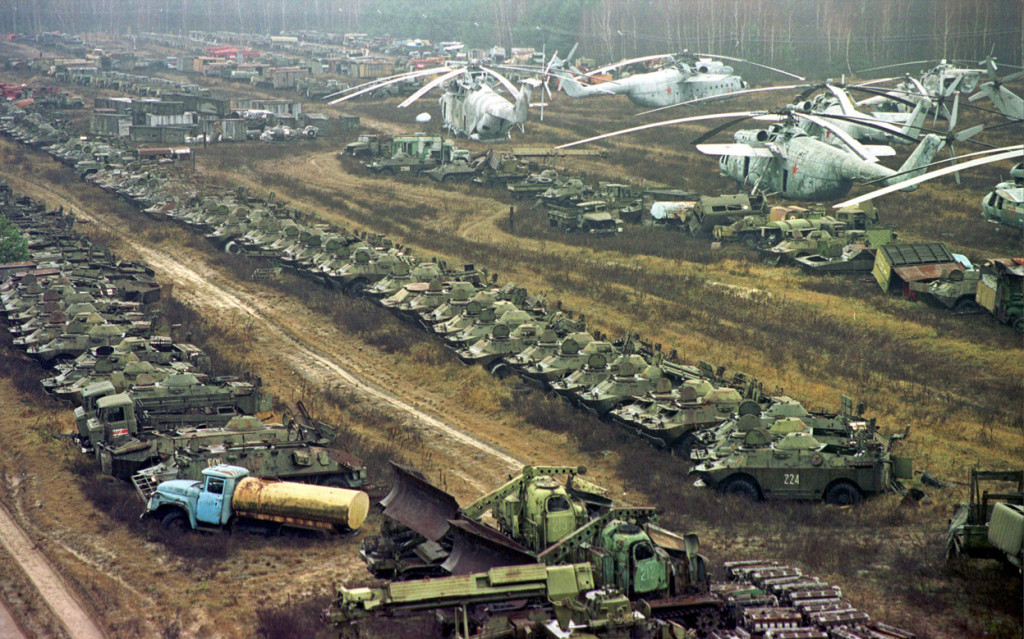
“On April 25, 1986 the area surrounding Chernobyl was full of action. The following day, everything came to a halt when Chernobyl Reactor #4 blew. Millions of dollars in land and equipment were left as people simply hoped to escape with their lives.”
“On April 25, 1986 the area surrounding Chernobyl was full of action. The following day, everything came to a halt when Chernobyl Reactor #4 blew. Millions of dollars in land and equipment were left as people simply hoped to escape with their lives.”
Technospheric Breakdown Comes of Age … and with a Vengeance.
Technospheric breakdown is a concept that most are not familiar with. It is rarely discussed in the mainstream media because of what it truly means for the entire planetary civilization. As a short description, consider that much of what has been built around the globe during the past 100 years belongs to the technosphere. To a great extent, it is represented by much of what has been created since the advent of the Industrial Revolution. We are using the term very loosely within the context of nuclear energy because of how critical it is to the integrity and longevity of the existing nuclear power generation paradigm.
As an example, when Superstorm Sandy blew through the US Northeast on November of 2012, it battered that regional technosphere. In so doing, it revealed weaknesses and vulnerabilities that only a storm of that size and magnitude could do. In what ways did Superstorm Sandy reveal the effects of technospheric breakdown throughout New York City? For one, the city’s well known subway system went completely down from Wall Street to the Battery. Old equipment, faulty wiring, saltwater meets metal machinery, and many other issues quickly surfaced under the assaults of the downgraded hurricane. Years of neglect and old parts combined to predictably reveal vulnerabilities with the unprecedented flooding of the underground subway system. The following excerpt comes from an insightful 2013 article that reviewed the superstorm saga as it affected Manhattan’s subway.
If a major hurricane hit New York City tomorrow, damage to the subway system would likely be worse than it was in the aftermath of Superstorm Sandy.
How is that possible?
That storm did $5 billion of damage to the Metropolitan Transportation Authority (MTA) systems, much of it caused by the flooding of subway tunnels.
Power outages in the wake of the storm slowed the rate at which the MTA could pump the tunnels clear, and millions of gallons of salt water took a heavy toll on tunnels filled with metal and electrical equipment.
And while the tunnels are dry for the moment, the heavy post-Sandy workload — pumping tens of millions of gallons of water over consecutive days — degraded the pumps. (Davies, A., 2013)
Looking at just the technospheric breakdown alone, without considering the ongoing and unsettling impacts of Earth changes, is where we will start in order to establish a frame of reference.
Upon assessing the typical nuclear power plant, like the one at Fukushima, what quickly came to light were the previously identified problems with the GE reactors (Washington’s Blog). They were widely known to have design flaws which made them unsound and unsafe. The longer that particular design is in operation, the greater the likelihood of a failure of some sort, and depending on the failure, potentially a major nuclear event. Bear in mind that there are other design flaws in the older nuclear reactors which either haven’t yet been found, or more importantly, are not talked about because they can trigger an immediate termination of licensing in the US by the Nuclear Regulatory Commission.
Again, the context that we would like to present is the one that assesses the normal wear and tear in a nuclear power plant environment. Because the industry is so young, and under so much scrutiny by some very smart scientists who have some degree of common sense, it is now understood that the stresses that exist in the nuclear plant environment are quite extraordinary, relentless as in 24/7, and highly destructive. After all, we are talking about the process of ‘controlled’ nuclear fission. How can the proper containment of such a profoundly destructive process not produce some unwanted unintended consequences to people, plant and the surrounding environment?
Does the current NEP really ‘contain’ the process of nuclear fission?
Taking a closer look at the process of nuclear fission, it is self-evident that such an inherently violent process was never easy to truly contain. The status quo found within nuclear power plants across the planet reveals many weaknesses, particularly the closer one gets to the actual nuclear reactors, and especially the nuclear reactor core. Engineering and design flaws notwithstanding, even if the reactors were manufactured perfectly according to the original blueprint, it has now been determined that there are fatal flaws which will reveal themselves the longer a nuclear reactor is in operation (Gunter, P.).
Scientists and engineers who have monitored the breakdown of the reactors and plants over decades are now seeing just how difficult it was to foresee the many problems that are emerging throughout the worldwide nuclear energy industry. With each passing year they observe different failures and malfunctions which speak directly to the “hostility” that nuclear power generation poses to everything and everybody found within a close proximity to the reactors. Hence, all the materials and parts, equipment and machinery, that is located in and around the nuclear reactors are always subject to partial failure or complete breakdown at a much faster rate than originally assumed. Nothing — not even the plant personnel — is going to last the projected life span that was insinuated during the startup of the industry.
This is a turnaround because until recently, the life expectancy of reactors was growing. When the Nuclear Regulatory Commission began routinely authorizing reactors to run 20 years beyond their initial 40-year licenses, people in the electricity business began thinking that 60 was the new 40. But after the last few weeks, 40 is looking old again, at least in reactor years, with implications for the power plants still running, and for several new ones being built (Wald, M.)
Herein lies a crucial issue for every nuclear power plant that has been in operation for over 40 years. The vast majority of nuclear reactors were designed during the 1960s and 70s. Hence, we have an industry that is still completely relying on the state of the art of that period. Even with the leaps in scientific knowledge and technological advancement over the same timeframe, the static nuclear power generation industry decided to stick with the original ‘blueprints’ for new projects. These blueprints, it is now known, contain serious defects and pervasive deficiencies.
Too Many Critical Decisions at the Very Top were Driven by Economics
It ought to go without saying that when playing with fire it would be wise to first make sure that it will not turn into a forest fire … or brushfire … or wildfire. In the case of the NEP, this golden rule was not followed. Because the global Nuclear Energy Industry was essentially hijacked by corporate interests at a rudimentary stage of development, the key financial decisions trumped all other more important considerations. Because important issues were taken out of the hands of the scientists and engineers early on, the design, engineering, manufacturing and construction of nuclear power plants were often driven by cost containment and profit margins, instead of radiation containment.
This single dynamic, which has operated to varying degrees throughout the industry, essentially sealed its fate. Because the actual costs associated with truly safe, efficient and high-integrity nuclear power generation are so high, the industry would never have built even a single power plant, except perhaps a prototype in order to study all that can go wrong in such a high intensity and relatively unknown environment. Little did the plant operators know that stresses — both macro and micro — would take a toll in ways that could not be anticipated.
In the current analysis by those “from whom reason has not fled”, it is clear that it is the subtle and unseen micro-stresses found within every nuclear reactor in the world which can cause the most serious problems. Because these unrelenting micro-stresses usually occur under the radar, they often go undetected for years or even decades. Then, one day a major failure occurs with a critical part or piece of equipment. The actual breakdown was never anticipated, but occurs as a result of a long-term stress manifesting in this way or that way.
Nuclear Power Plants Use Outdated Protocols and Inadequate Maintenance
In light of the fact that there are so many unsolved and/or unresearched problems within the NEP, the plant operators don’t even know what they don’t know. Stated another way, willful ignorance of some of the most significant issues due to the cost of remediation has blinded the corporate decision-makers to the real and needed solutions. It pays them not to know just how catastrophic some of the ‘unexpected’ outcomes can be in the face of inordinately expensive yet necessary overhauls of the plant, materials and/or reactor parts.
Studies have been conducted which have conclusively shown that the actual wear and tear observed in every nuclear plant environment has exceeded what was originally anticipated. As an example of what the industry has learned over the short history of nuclear power generation, the following excerpt delineated only some of the “Metal Aging Degradation Mechanisms” which are routinely found in a nuclear power plant.
This is a partial listing of aging degradation mechanisms for metals, with examples of effects greater than anticipated in plant design and methods to address them.
Corrosion: deterioration of a material resulting from reactions with its environment.
Some steam generator components, piping, pressure vessel internals, and other plant areas have experienced more extensive corrosion than originally assumed during plant design. Major forms of corrosion include wastage, stress corrosion cracking, erosion/corrosion, crevice corrosion, and intergranular attack.
Methods for alleviation include inspections for signs of deterioration, control of water chemistry, or replacement with resistant materials or designs.
Fatigue: the deterioration of a material from the repeated cycles of thermal or mechanical loads or strains. Some fatigue failures in piping and other components have occurred, often resulting from larger than anticipated loads or combinations with other degradation mechanisms (e.g., corrosion).
Methods for alleviation include inspections and more accurate estimates and monitoring of the magnitude and frequency of cyclic loads.
Embrittlement: change in a material’s mechanical properties such as decreased ductility and reduced tolerance to cracks resulting from thermal aging or irradiation.
Some embrittlement has been found to be more rapid than originally anticipated in plant design. Neutron irradiation of reactor pressure vessels (RPVs), for example, can lead to a more rapid loss of ductility than expected, particularly when copper and nickel are contained in RPV weld materials.
Methods for alleviation include more accurate estimates of thermal exposure and neutron fluence histories and their effects, revised operations (e.g., arranging fuel to reduce neutron flux to certain RPV regions), and component replacement or refurbishment (e.g., RPV annealing).
Fabrication defects can contribute to more rapid fatigue cracking and corrosion.
Casting and forming defects and weld-related defects embedded in a material may worsen from cyclic loadings, or such defects may become exposed by corrosion. Methods for alleviation include inspections using non-destructive examination techniques to detect embedded flaws early, and repairs.
Mechanical effects include vibration, water hammer and wear. Vibration and water hammer can result from fluid flows and result in loads greater than explicitly considered during design, contributing to fatigue failures and damage to pipes, valves, and pumps. (U.S. Congress, Office of Technology Assessment)

When put into proper perspective, this particular set of material assessments and mechanism analyses is as shocking as it is alarming. That any or all of these degradations occur wherever nuclear reactors are churning away should have given great concern to those who regulate the industry. And yet we rarely hear that the regulatory bodies focus on any of these types of inevitable decay and common disrepair found within every nuclear power plant.
The reason we don’t hear about these is because once the costs were sunk into every enormously expensive power plant, the only way to recoup them was to permit them to run as long as possible, irrespective of the serious safety and inevitable breakdown issues. Of course, with the onslaught of Earth changes and acceleration of technospheric breakdown, the known processes of deterioration will only increase in number and intensify depending on how exposed each power plant is.
The biggest factor, however, is how religious nuclear power plant operators are — in each locale — with regard to the required maintenance and part replacement schedules. The engineers have always been aware of the obvious weak points in the system, which require regular monitoring and preventative measures. In fact, the entire industry has been performing many acts of overcompensation for years to ensure that nuclear accidents are kept at bay, as demonstrated by the extraordinary work records kept when plants shut down for unplanned yet “required” maintenance.
Nevertheless, problems arise in many instances where maintenance is not undertaken, and where parts and equipment are not replaced, because those issues have not even been officially addressed by either the industry or the regulatory bodies. The local operators can easily err on the side of neglect because of the cost pressures which have continued to erode profit margins, which were overzealously projected at the outset of the industry.
The US Nuclear Power Program is Based on an Exceedingly Bad Business Model
Bear in mind that the following quote comes from a 1986 issue of Forbes Magazine, and that the economic and financial status quo throughout the US nuclear power industry has only sunk lower since the mid 1980s.
The failure of the U.S. nuclear power program ranks as the largest managerial disaster in business history. The utility industry has already invested $125 billion, with an additional $140 billion to come before the decade is out – and only the blind, or the biased, can now think that money has been well spent. – Forbes Magazine, February 1986
Maintenance procedures and preventative measures, plant overhauls and cold shutdown, temporary plant closures and premature decommissionings have plagued the nuclear energy industry from the very beginning. It is now experiencing a snowballing of these events, as the costs associated with them are skyrocketing. What relevance does this worsening predicament have to Earth changes and technospheric breakdown?
First, both of these major co-factors — Earth changes and technospheric breakdown — will only intensify for the foreseeable future. As they do, the business model that undergirds the nuclear energy industry will become more untenable. Not only is nuclear power generation the most cost ineffective of all the major energy-producing platforms, it is vulnerable to the greatest costs associated with required maintenance and repair, as well as failure prevention and remediation in the wake of a nuclear accident.
Clearly, because of unrealized revenue generation targets and cost overruns alone, the NEP business model is unsustainable. Global Climate Change and Technospheric Breakdown will only create an environment wherein costs will continue to escalate dramatically as the many aging plants worldwide get older and more decrepit. Ultimately, a breaking point will be reached whereby the current form of the Nuclear Energy Paradigm will no longer be a reasonable business proposition; not that it ever has been.
That Fukushima has placed such an exceptional financial burden on TEPCO validates this ubiquitous and ongoing scenario. Not only has Fukushima effectively bankrupted TEPCO, it has placed a huge cost burden on the Japanese government. It also has the potential to drag down every other business concern associated with TEPCO. The Japanese government is not immune to the extraordinary claims which may be filed in the future by the countless citizens and businesses that have legitimate grievances. These unfunded liabilities alone may end up taxing the people in ways never seen before.
The international cost ramifications have been curiously downplayed in this regard. However, given the current state of tensions between Japan and some of its neighboring countries, the current compassionate stance can easily be replaced with an understanding that Japan really screwed up, and that it ought to be held liable for damages related to all Fukushima-generated radiation damage. If damages could be proven in an international court of law, both China and North Korea might have a serious change of attitude in the not-too-distant future.
Perhaps then the politicians in Tokyo will begin to respond to this matter with prudence and foresight. The current energy policy surrounding nuclear power has been a gross failure, even when based on economics alone. Since 2011, so much has happened, and not happened, throughout the Japanese nuclear energy industry that it is a wonder any money is still allocated toward its proliferation.
Technospheric Breakdown is Accentuated by Earth Changes
The point of this part of the discussion is that as technospheric breakdown accelerates, and it is now accelerating at an ever-increasing rate because of old plants and infrastructure which are approaching the end of their lifetime, the technosphere is also exposed to the intensifying assaults that come with Global Climate Change and other major Earth changes. Because of this rapidly evolving worldwide predicament, the entire technosphere is now much more susceptible to both systemic breakdowns and isolated failures. Of course, a perfect storm of multiple isolated failures significantly increases the risks for systemic breakdown. As an example, the Fukushima nuclear disaster provides various instances in which the systemic breakdown produced emergency situations, and also of where different isolated failures worked their way into the system with tremendous consequences.
Neither TEPCO nor the Japanese government is too keen on making these types of observations. When the ongoing and ever-worsening predicament of technospheric breakdown is considered in any objective analysis — before, during or after the event — there can only be one conclusion. The ultimate determination that one can draw from the facts on the ground at Fukushima is that the Daiichi Nuclear Power Station shouldn’t even be there. Nor should any other nuclear power plants which have been sited on any of the coastlines of Japan, so vulnerable as they are to earthquakes, tsunamis and typhoons.
In this new era of unpredictable and cataclysmic Earth changes, this obvious conclusion cannot be overstated. It is also applicable to every other nuclear power plant in the world that is located on or very near a shoreline or fault line, large river bank or volcano. Clearly, the scientists and engineers, architects and designers, manufacturers and builders who drew up or contributed to the original plans for nuclear power generation infrastructure never anticipated these eventualities. Why they did not simply defies common sense. The result is this – the horrific devastation at TEPCO’s Fukushima Daiichi Nuclear Power Station (See Graphics [5], [6] and [7]).
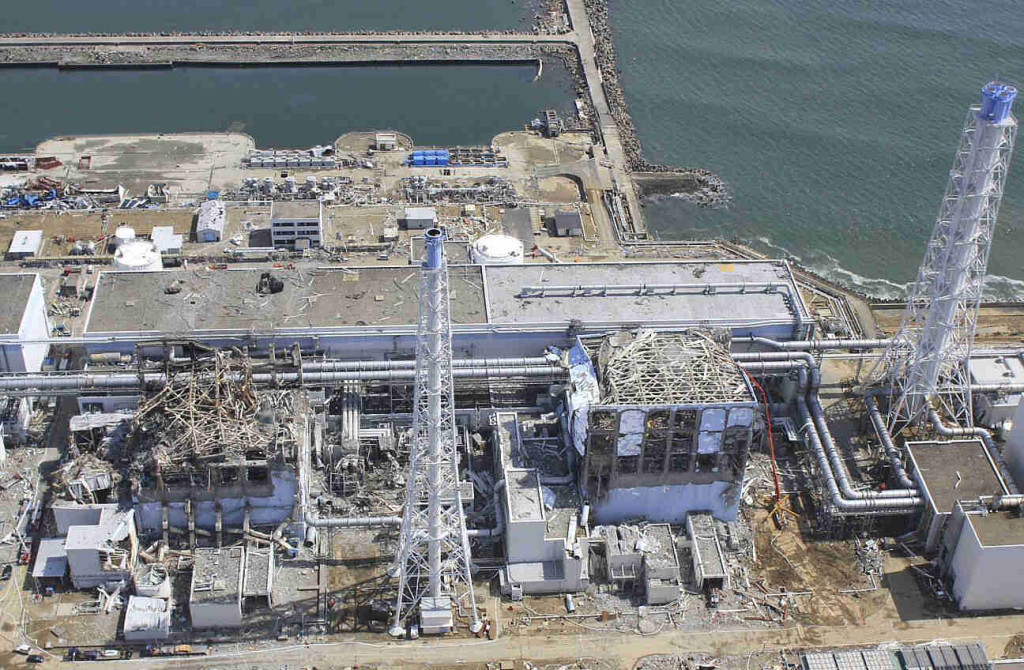 Graphic #5 — Fukushima Daiichi Nuclear Power Station
Graphic #5 — Fukushima Daiichi Nuclear Power Station
Japan has had different reasons to flatly reject nuclear energy
Particularly in light of Japanese sensibilities, as well as its poignant history, it is quite shocking for the rest of the world to watch their plight. Japan’s neighbors — both near and far — have watched in horror as this nuclear disaster has evolved. Those nations have been concerned about the developing outcomes at Fukushima, not only for the welfare of the Japanese people, but also of their own citizens, which brings us to the point of social responsibility.
Decisions such as instituting a national energy policy that revolves around nuclear power generation can no longer be made in a vacuum. Japan, being an island nation, has always been somewhat isolated. Culturally, they are a very homogenous people and therefore tend toward groupthink. However, the Japanese government is now obligated to think outside the proverbial box. Their actions — and inactions — can and do have far-reaching repercussions for their neighbors, as well as the rest of the world.
When the potential consequences of Japan’s actions are as grave for the Pacific Ocean community as the Fukushima event, it would seem incumbent upon them to consider very carefully any and all decisions regarding nuclear energy. Even the USA, far across the same ocean, is quite vulnerable to such misguided past decisions, as Japan is vulnerable to bad US nuclear policy. Of course, there is poetic justice in this since much of the nuclear industry technology and infrastructure in Japan was sold and/or built by American companies.
Nevertheless, the Japanese were staring at a veritable sea of red flags at the very inception of the nation’s nuclear energy policy. Having two cities destroyed, and upwards of 300,000 citizens killed by two atomic bombs, should have given them reason to pause. Being geographically situated in such an extraordinarily active seismic zone provided another opportunity to step back before the green light was given to nuclear power as energy policy.
Particularly in view of the awesome devastation which occurred during the Great Hanshin earthquake in Kobe in 1995, Japan had an excellent vantage point from which to observe the vulnerability of all its infrastructure. At that very moment in time, it was clear that the current building codes (and site locations) throughout the nuclear energy industry were wholly inadequate. Likewise, that the state of the art of nuclear technology was profoundly insufficient to withstand such earth-shaking assaults intact.
Furthermore, Japan has been way ahead of the curve where it concerns the acceleration of technospheric breakdown. Downtown Tokyo has given them many opportunities to observe and assess the wear and tear that is sustained each and every day by infrastructure and technology in an urban environment.
Every time Tokyo is hit by a typhoon or unsettled by an earthquake, the entire city experiences damage, much of which is unspoken or unwritten. The amount of underground destruction to water mains, subways, fiberoptic internet cables, telecommunication wiring, and other infrastructure in the wake of a severe earthquake can be enormous. Some of the more hidden damage can go undetected for months, or even years. Eventually, after the ongoing technospheric breakdowns continue to whittle away at the integrity of the overall system or grid, it only takes a small trigger event to precipitate a system-wide failure … which can then cause a domino effect resulting in a regional collapse … or even a national event. As ‘advanced’ as Japan has become in the area of information technology, it ought to have become clear how things can break down very quickly because of the interpenetration of so many different realms essential to keeping a nuclear power plant running properly.
Now that may be ‘okay’ or quite resolvable with the array of problems that routinely present in the wake of a typhoon or earthquake, but it isn’t acceptable where it concerns nuclear mishaps, as the world witnessed in Fukushima. We now live in a new world. With events such as Hurricane Katrina, the BP Gulf Oil Spill, the Fukushima Nuclear Disaster, Superstorm Sandy, 500 and 1000 year floods occurring yearly, and many other catastrophic events both natural and manmade, a new paradigm must be considered. Not to do so at this very late date is to do so at our collective peril.
Preventative measures must be taken in the meantime, especially by Japan.
There are substantial preventative measures related to nuclear power plant configuration which can be taken by Japan, as well as by other countries in similar positions, in order to avert potential calamities like Fukushima. However, these can only be implemented with a full understanding of the Earth changes which have been visiting every corner of the globe. Whereas Japan has been stuck in denial about their NEP, they must also understand that, as a multi-island nation located out in the Pacific Ocean on the Ring of Fire, they are inordinately exposed. Typhoons, earthquakes, tsunamis, volcanoes (Wikipedia, List…) will certainly always pose threats; therefore, why not take the necessary preventative measures that can be taken to minimize the worst possible outcomes.
In the case of Japan’s nuclear power plants, the best preventive option would be a systematic closing down of each and every plant on the four main islands of Japan. This could occur with the phasing in of other energy sources which would help meet national energy requirements. If this isn’t happening already, it should have started on March 11, 2011.
This solution is being offered as the primary one of all possible solutions where it concerns Japan’s Nuclear Energy Industry. The thesis should be transparent by now: When the nuclear energy paradigm collides with Earth changes and technospheric breakdown, there is only one answer. An unequivocal case has been made in this chapter for the deliberate closing down of the current nuclear power industry throughout Japan. There is no more wiggle room. And, by the way, wherever earthquakes occur in such numbers and severity, wiggle room is what it all comes down to.
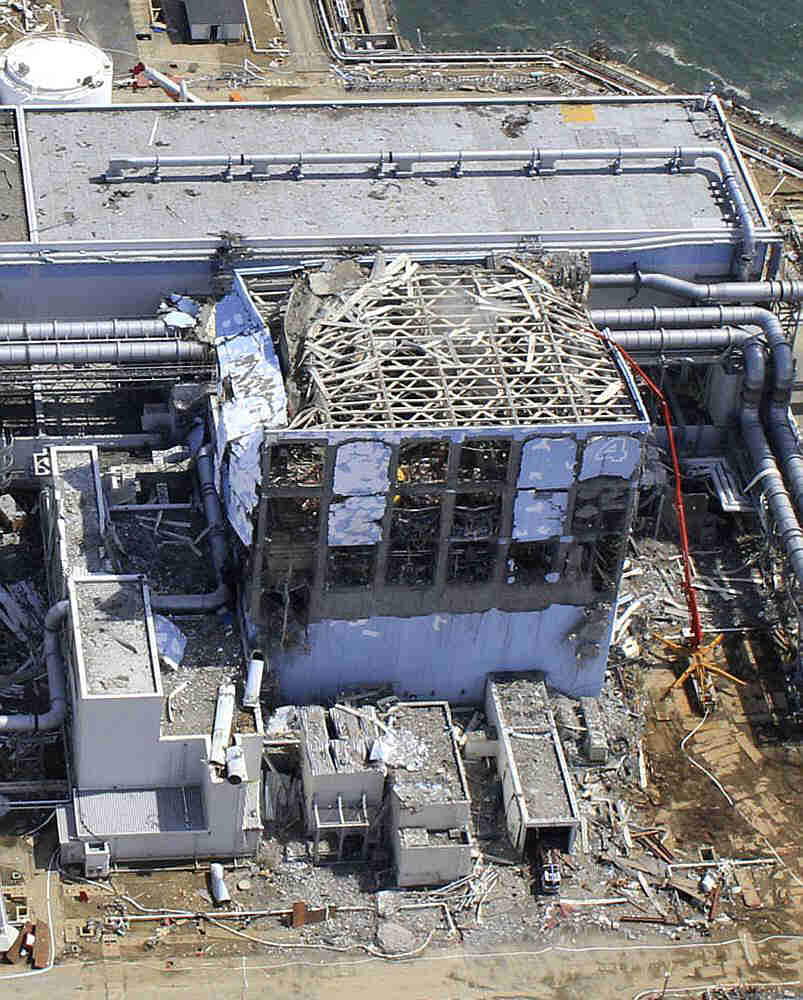 Graphic #6 — Fukushima Daiichi Nuclear Power Station
Graphic #6 — Fukushima Daiichi Nuclear Power Station
As Technospheric Breakdown Accelerates, Nuclear Power Generation Mishaps will Increase and Intensify
There is really no way around this eventuality. As all the nuclear power plants age, they will succumb to the micro-stresses which inevitably occur in such an ever-deteriorating environment. Most people are unaware of the true depth and breadth of technospheric breakdown since it is a concept rarely taken up by academia or the media. The following excerpts provide a wider perspective of this unavoidable byproduct of the Industrial Revolution.
Technospheric breakdown is something that occurs everywhere around the globe, 24/7, without interruption, and with tremendous repercussions. Let’s start with anything that has been manufactured in the factories of the modern world or built on the surface of the Earth. Simply put, everything is in the constant state of breaking down, degeneration, deterioration.
What does this really mean when we say that every bridge is slowly breaking down, every road is in greater disrepair with each passing day, every reservoir is gradually degrading, every office building, every factory, every school, every home, etc. most of which adhered to very low building standards in the first place?
What does it mean when the infrastructure for every sewer system, municipal water division, electrical grid, airport, railway station, etc. is in a slow but sure process of degrading and breaking down. So, unfortunately, is every nuclear power plant across the planet. (Cosmic Convergence)
What makes this ongoing process of physical degradation so insidious is that it almost always occurs subliminally. Through a gathering array of various forces throughout post-modern civilization, there does exist a sort of conspiracy of circumstances which has greatly magnified the effects of technospheric breakdown. The completed marriage between the industrial base of the Western powers and the financial class throughout the world has guaranteed that this slow motion collapse will continue unabated. How so?
Because so many corporate decisions are made according to their impact on the bottom line, many inferior nuclear power plants have been constructed around the globe. Likewise, because the mega-banks and investment houses are now dictating to a financially-strapped Nuclear Energy Industry, substandard nuclear reactors have been designed, engineered and continue to be put into operation across the planet. One only has to take a close look at the websites dedicated to decommissioned nuclear reactors or cold shutdowns or partially closed nuclear power plants or emergency actions taken at various nuclear power generation sites to grasp just how precarious a position the entire industry is currently in.
Unknown to even many of the nuclear engineers who address these issues ‘in the office’, or who fix the cascade of problems at nuke plants themselves, is the notion of slow motion, subclinical, pernicious technospheric breakdown. It often manifests in ways where cause and effect cannot be easily established because of some of the unseen forces produced by atomic fission. With that said, it should be noted that a chapter could easily be dedicated to this particular issue alone, so significant is it to the future of nuclear power generation
Then there is the problem of nuclear wastes and natural rights, yes?
No one has articulated this point better than Albert Bates in his definitive essay entitled The Karma of Kerma: Nuclear Wastes and Natural Rights (Bates, A.K., 1988)
This extremely lucid and illuminating, sober and sane treatment of the greatest ongoing environmental disaster of our times lays bare the most basic legal and human rights issues which converge around the production, treatment and storage of nuclear wastes. Were the governments of the world to read and take to heart its simple and straightforward thesis, the current incarnation of nuclear energy production would have been abandoned years ago:
The disposal of radioactive substances in a manner that anticipates their eventual partial release into the human environment imposes a health burden upon future generations that cannot be justified by any moral or legal rationale. Like an irresistible force meeting an immovable object, the concept of the greater good for the many in the present generation runs against the concept of the inalienable rights of each individual in future eras. At present, in matters involving nuclear power, our governmental agencies have taken the side of the irresistible force. But when federal agencies venture to tread beyond of the scope of the foundation principles with which the federal government was fashioned, they endanger more than human lives. At risk in the nuclear waste debate are long-held concepts of ordered liberty. (Bates A. K., 1988)
Fukushima has illustrated exactly why this elegantly stated legal concept of human rights and moral imperative is so pertinent to the public discourse. When massive amounts of radioactive wastewater are dumped into the Pacific Ocean, not only human life will be adversely affected. Marine life has been negatively impacted in ways that will take decades to observe and comprehend. The outright destruction of the environment in and around Fukushima and the Pacific Ocean must also be considered in any meaningful assessment of collateral damage.
Perhaps even more than Chernobyl, Fukushima has allowed the global community to view the whole event through the lens of legal responsibility and ethical outcomes so that new international standards can be written and implemented regarding nuclear waste conveyance and disposal. If nothing else, this discussion has raised awareness about the most nagging issue concerning the NEP. Whereas the human rights aspect confers the legal right to not be contaminated by nuclear radiation has barely been addressed by those responsible for it consequences, it now enjoys a prominent place throughout the worldwide debate.
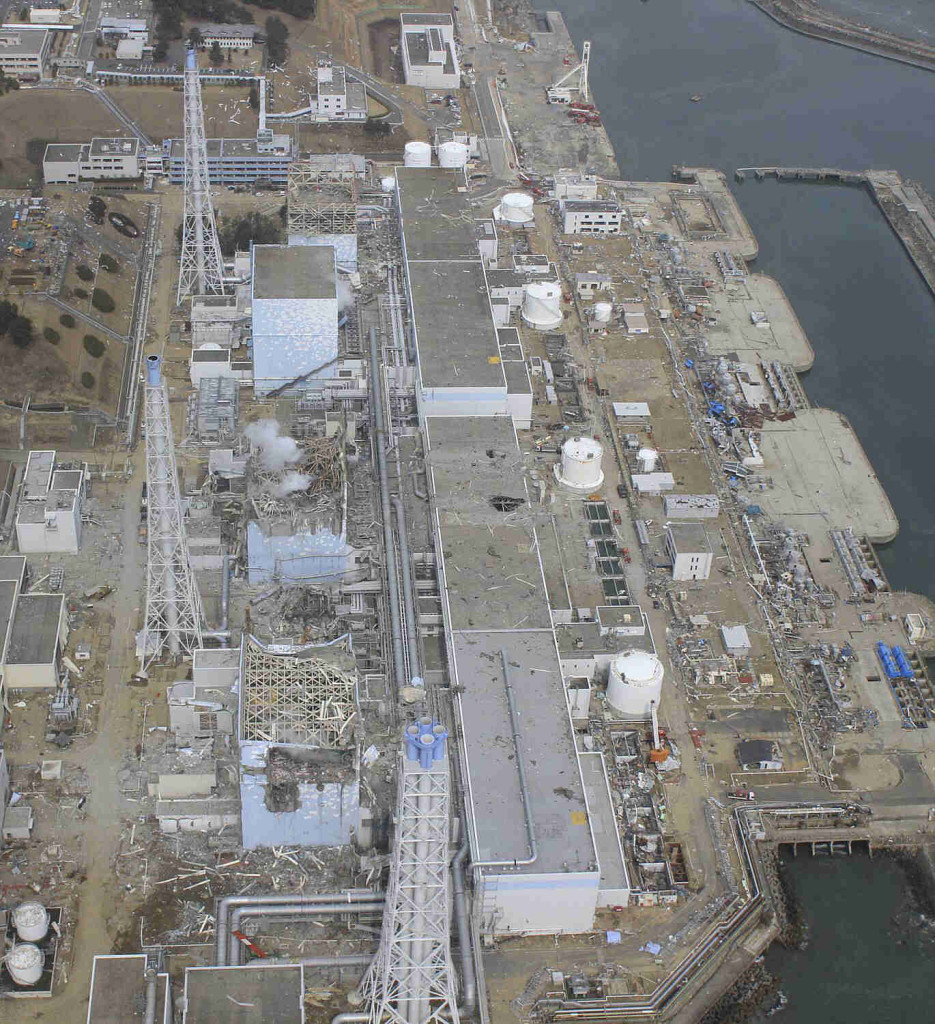
Graphic #7 – Fukushima Daiichi Nuclear Power Station
Fukushima:
Wakeup Call of the Millennium
Accidents and mishaps, manmade and natural disasters happen. Things are fixed fairly quickly in this postmodern age, and life goes on. Whether these events occur in a full-blown war zone or in the wake of a hurricane, the affected population usually does everything it can to rebuild and move on.
However, when these events take place in or near nuclear power plants, life doesn’t just go on. It often stops. Depending on the circumstances and seriousness of a nuclear event, sometimes life stops in that area for a long time.
Our civilization has now been given three unmistakable wakeup calls since the advent of the nuclear power generation era. First there was Three Mile Island in Pennsylvania, then there was Chernobyl in the Ukraine, and lastly the world is still reeling from the specter of possibilities which are presented by Fukushima.
Surely it is not by chance that these three flagrant examples of nuclear Perfect Storms occurred around the globe affecting major nations and populations centers. Each of these disasters has served to wake up whole swaths of humanity to the dangers and risks which are associated with the current Nuclear Energy Paradigm. To ignore, or deny, or refute the obvious lessons which all three nuclear catastrophes have given to humankind would be folly of the highest order.
The global impact of Fukushima, which has disseminated radionuclides (radioactive contaminants) by air and by way of the largest of the seven seas, stands as dramatic testimony to all that can go wrong — seriously wrong — with the current nuclear energy business model and method of power generation. Can it get any worse than Fukushima? That we are compelled to even ask this question speaks volumes about the true state of the affairs on that 25 square mile patch of land and contiguous sea which surround the Fukushima Daiichi nuclear disaster site.
Given this inescapable testament of nuclear folly, it is now incumbent upon the community of nations to rally around the obvious necessity of terminating the current form of the Nuclear Energy Paradigm. Why? Because when a “China Syndrome” occurs anywhere in the world, it will inevitably affect the entire planet. In other words, an INES Level 7 (Wikipedia, International Nuclear Event Scale) nuclear catastrophe does not respect borders. Nor does it discriminate between the young and old, healthy and sick, or those who live close to ground zero from those who live far away.
Therefore, any nation that chooses to set up a nuclear energy-producing operation from this point forward has an inviolable responsibility to its neighbors, as it does to the rest of the world. Likewise, those nations have a moral obligation to proceed in a manner that guarantees its neighbors will not be exposed to the consequences of its nuclear accidents, even when they are caused by duel natural disaster events as we saw at Fukushima.
Just as Europe was contaminated with radiation from Chernobyl (Yablokov, A.V., 2009), and North America has been contaminated from Fukushima, it is understood that once a nuclear catastrophe spirals out of control, the genie of radioactive contamination cannot be put back in the bottle. The entire Pacific Rim, in fact, has varying degrees of exposure to the radioactive waste water being conveyed by the ocean from Fukushima, as does the Western Hemisphere to seaborne radioactive isotopes like Cesium-137 and airborne isotopes such as Iodine-131(Center for Marine and Environmental Radiation).
Consequently, Japan is responsible for the damage wrought to the largest ocean on Earth. Have they acknowledged this? Have they approached the nations both near and far which have been affected by their cavalier and irresponsible approach to siting reactors up and down their seismic shorelines? Has the United Nations even addressed this extremely important issue known as national accountability? Or territorial sovereignty?
Conclusion
It doesn’t get very much more weighty than the ‘fallout from Fukushima’. All of the affected nations have been curiously silent on this issue. It is almost as though a conspiracy of silence has descended upon the concerned countries because of how unpredictable and intractable the nuclear containment problems have been at the Daiichi plant.
At the end of the day the current race of humanity will look back on the Fukushima Nuclear Disaster as the defining moment for both the industry and the underlying paradigm. If they haven’t already, the various stakeholders will be forced to re-evaluate the integrity of their nuclear enterprises around the globe. Hopefully, they will begin to take aggressive preemptive measures to address whatever needs to be addressed at every nuclear site still in operation.
If a decisive response is not formulated and implemented on a global scale, in light of the hard lessons learned from Fukushima, the current planetary civilization will be compelled to face up to these fatal flaws in most unpleasant ways, which will continue to manifest with each major Earth change. In a similar way, the inherent defects of the NEP will only be accentuated as technospheric breakdown accelerates. The profound and fundamental shortcomings which pervade the entire nuclear energy industry can no longer be hidden or ignored.
After all, it was the dangerous combination of willful blindness and feigned ignorance which got the world into this position in the first place.
“Does anyone in their right mind believe that nuclear power plants can ever be designed, engineered or constructed to withstand 9.0 earthquakes followed by 15 meter high tsunamis? Sorry if we offend, but such a display of so deadly a combination of ignorance and arrogance must represent the very height of hubris. Particularly in view of the inevitable consequences which have manifested at Fukushima, how is it that so few saw this pre-ordained and disastrous outcome, except by willful blindness?”
(State of the Nation)
Japan should never have sited 55 nuclear reactors (plus 12 others) on its coastlines. Which begs the question: Why did they?
The following observation has been made by many experts and laypeople alike since March 11 of 2011.
“Quite purposefully, no one ever stopped to consider the obvious and far-reaching ramifications of constructing 55 nuclear reactors on the most seismically active piece of property on Planet Earth! And, that doesn’t count another 12 reactors in various stages of planning or development.”
(State of the Nation)
Graphic notes
[1] Japan NPP map http://cosmicconvergence.org/wpcontent/uploads/2014/07/japan.jpg
[2] Japan 3/11/01 Earthquake: Helicopter aerial view video of giant tsunami waves
▶ Japan Earthquake: Helicopter aerial view video of giant tsunami waves – YouTube
[3] Fort Calhoun Nuclear Power Station during the floods of June, 2011 (1) http://cosmicconvergence.org/wp-content/uploads/2014/07/fort-calhoun-nuclear-station.top_.jpg
[4] Fort Calhoun Nuclear Power Station during the floods of June, 2011 (2) http://cosmicconvergence.org/wp-content/uploads/2014/07/1280px-Calhoun-Corp_of_Eng._6-16-11A_266.jpg
[5] Devastation at TEPCO’s Fukushima Daiichi Nuclear Power Station (1) http://cosmicconvergence.org/wp-content/uploads/2014/07/pict5.jpg
[6] Devastation at TEPCO’s Fukushima Daiichi Nuclear Power Station (2) http://cosmicconvergence.org/wp-content/uploads/2014/07/pict12.jpg
[7] Devastation at TEPCO’s Fukushima Daiichi Nuclear Power Station (3) http://cosmicconvergence.org/wp-content/uploads/2014/07/pict13.jpg
References
Associated Press. Magnitude 6.8 earthquake off Japan coast triggers tsunami. July 11, 2014. http://www.wjla.com/articles/2014/07/magnitude-6-8-earthquake-off-japan-coast-tsunami-alert-issued-105009.html
Bates, A. K., Karma of Kerma. Journal of Environmental Law and Litigation. Univ. of Oregon School of Law, Vol 9, Page 3, February, 1988. http://www.thefarm.org/lifestyle/albertbates/akbp5.html
Blodget, H. The US Is Having A Catastrophic Nuclear Emergency In Nebraska And The Obama Administration Is Covering It Up. Russia, Business Insider, June 19, 2011. http://www.businessinsider.com/nebraska-nuclear-meltdown-2011-6
Center for Marine and Environmental Radiation, Woods Hole Oceanographic Institution. How Radioactive is Our Ocean? http://www.ourradioactiveocean.org/
Cosmic Convergence. Technospheric Breakdown: Ongoing, Ubiquitous and Unstoppable. January 2, 2012. http://cosmicconvergence.org/?p=3717So%2c%20unfortunately%2c%20is%20every%20nuclear%20reactor%20across%20the%20planet.%22
Davies, A. NYC Has Some Big Ideas To Save Its Subways From The Next Superstorm, Business Insider, June 13, 2013. http://www.businessinsider.com/nycs-subway-isnt-ready-for-another-sandy-2013-6
Forbes Magazine, February 1986. In Nuclear Reader, Chapter Two, Nuclear Power is Bad Business. http://www.nuclearreader.info/chapter2.html
Funk, J. and Nelson Lampe. Fort Calhoun Nuclear Plant: Flood Seeps Into Turbine Building At Nebraska Nuke Station, Huffington Post, 06/27/11. http://www.huffingtonpost.com/2011/06/27/fort-calhoun-nuclear-flood-nebraska-plant_n_885067.html
Gunter, P. Hazards of Boiling Water Reactors in the United States – Nuclear Information and Resource Service (NIRS), March, 1996, updated by Michael Mariotte, NIRS, March 2011 http://www.nirs.org/factsheets/bwrfact.htm
Hargreaves, S. Flooded Nebraska nuclear plant raises broader disaster fears, CNN. June 28, 2011. http://money.cnn.com/2011/06/28/news/economy/nebraska_nuclear_plant/
Kageyama, K.Typhoon Neoguri Slams Into Okinawa, Generating 46-Foot Waves, Huffington Post. 07/07/2014. http://www.huffingtonpost.com/2014/07/07/typhoon-neoguri_n_5562427.html
State of the Nation. The Pacific Ocean Is Dying: A Special Report On the Fukushima Nuclear Catastrophe, October 29, 2013. http://stateofthenation2012.com/?p=2289
Sulzberger, A. G. and Matthew L. Wald, Flooding Brings Worries Over Two Nuclear Plants. The New York Times, June 20, 2011. http://www.nytimes.com/2011/06/21/us/21flood.html?_r=1&
The Doc. Fort Calhoun Nuke Plant Flood Wall Collapse The Result Of Accidental Puncture, SilverDoctors, June 26, 2011. http://www.silverdoctors.com/fort-calhoun-nuke-plant-flood-wall-collapse-the-result-of-accidental-puncture/
Tokaimura Nuclear Accident http://en.wikipedia.org/wiki/Tokaimura_nuclear_accident
U.S. Congress, Office of Technology Assessment, Aging Nuclear Power Plants: Managing Plant Life and Decommissioning, OTA-E-575 (Washington, DC: U.S. Government Printing Office, September 1993). (Chapter 2, Safety of Ageing Nuclear Plants, p.38) Please see the following URL for the material mentioned here: http://cosmicconvergence.org/wp-content/uploads/2014/07/Screen-Shot-2014-07-15-at-6.31.48-AM.png
Wald, M.L. Nuclear Plants, Old and Uncompetitive, Are Closing Earlier Than Expected. June 14, 2013, The New York Times. http://www.nytimes.com/2013/06/15/business/energy-environment/aging-nuclear-plants-are-closing-but-for-economic-reasons.html?_r=0
Washington’s Blog. Fukushima: General Electric Knew Its Nuclear Reactor Design Was Unsafe … So Why Isn’t GE Getting Any Heat for Fukushima? Global Research, December 12, 2013. http://www.globalresearch.ca/fukushima-general-electric-knew-its-nuclear-reactor-design-was-unsafe-so-why-isnt-ge-getting-any-heat-for-fukushima/5361300
Wikipedia, International Nuclear Event Scale. http://en.wikipedia.org/wiki/International_Nuclear_Event_Scale
Wikipedia, List of volcanoes in Japan. http://en.wikipedia.org/wiki/List_of_volcanoes_in_Japan
World Awash in Environmental Armageddon, Japan: A Nation Consigned To Nuclear Armageddon, An Open Letter to the People of Japan. March 17, 2011. http://environmentalarmageddon.wordpress.com/2011/03/17/japan-a-nation-consigned-to-nuclear-armageddon/
Yablokov, A.V., Vassily B. Nesterenko. Alexey V. Nesterenko. 2009. Chernobyl Consequences of the Catastrophe for People and the Environment, New York Academy of Sciences. http://environmentalarmageddon.files.wordpress.com/2011/03/chernobyl-sm.pdf
Copyright © 2014 by Majia Holmer Nadesan
To read the whole book, click here:
Fukushima: Dispossession or Denuclearization?
